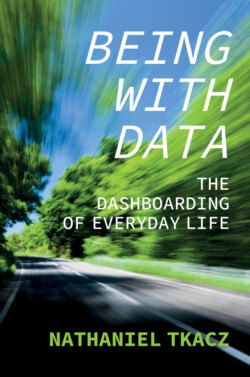Читать книгу Being with Data - Nathaniel Tkacz - Страница 10
Culture
ОглавлениеThis is a book about culture. Ordinary, everyday things.45 Saturday morning runs, consumer devices, screens, work, ways of seeing and thinking, ways of being. Things that are easily overlooked because they gradually blend into the status quo without much hoo-ha. In the case of dashboards, this book is about a thing that was once not very ordinary becoming so; and about an ordinary thing in one sphere (transportation) becoming ordinary in others. It is about culture becoming data culture and dashboard culture; about the formatting of culture and the culture of formatting.
How does culture enter the picture? Some points of clarification are needed as there are many possible ways one might bring culture and data/dashboard/format together. Culture or cultural categories can serve as the content of data or what is represented by data, for example, as found in the research subfield of ‘cultural analytics’.46 Much of the work that goes by the name of digital humanities also deals with things that are traditionally understood as cultural, and we could generalize to include any other studies where things deemed cultural are the focus of a data-driven inquiry. One can access and make claims about ‘culture’ through extracting data from the diversity of documents (text, images, links etc.) that characterize our digital society and populate its archives (data centres). In this sense, culture is data’s subject matter, its topic, if you will.
In a very different way, ‘culture’ can be invoked to critique the authority of data, its presentation formats and related algorithmic processes. Here, culture might be contrasted with science, such that data-driven and algorithmic processes are found to contain cultural ‘biases’ related to gender, race, age and other markers of identity. Such perceived biases may be located in the data themselves (e.g., their categories), the methods for manipulating and displaying data, or the institutions and settings within which data are produced. When we invoke culture in this way it is often to reveal problems with data that have not been seen or addressed by those who work with data. There are now many excellent studies that fall into this category.47
What I am interested in, though, is not culture as topic or culture as bias or counterpoint to a presumed scienticity. I am not hoping to discover some hidden elements, a cultural ‘Where’s Wally?’48 among an otherwise technical and scientific mise en scène. And I am not interested in creating a strong contrast between science and culture. The tradition of science and technology studies has taught us to tread carefully with these matters. Rather, and taking my cue from this tradition, I want to treat data and dashboards as culture. A dashboard doesn’t merely contain cultural elements, display cultural data or exist in cultural situations. It is always already a cultural entity. No further ingredients are required; no discoveries of bias, no contrast to science. A dashboard facilitates ways of being – with data, as we have seen – and ways of thinking, alongside ways of relating to time, space and other people and things. It always already partakes in and contributes to certain ways of living. This understanding of dashboards (as everyday/ordinary and facilitating ways of being) resembles something of Raymond Williams’ approach to culture precisely as ‘a whole way of life’.49 Williams’ account of culture is multifaceted and I can’t do it justice here, but it includes traditions passed down and understood as ‘ideals’, works of expressive creativity (‘intellectual and imaginative work’) and a ‘particular way of life’ with particular sets of ‘meanings’, ‘values’ and ‘behaviours’.50 As a ‘way of life’ Williams understood culture as ordinary and lived. When I say this is a book about culture, it is because I am interested in exploring the ordinary, lived experience of dashboards. I am interested in how they alter how we act, how we perceive and relate to things and each other; how dashboards tend towards a certain ‘habit of the mind’ (to use another definition offered by Williams). And, like Williams, I am interested in this relationship between the ‘ideal’ – or what I prefer to think of more basically as things that persist over time – and the ‘lived’ that always negotiates new settlements with these persistent things.
Through their arrangements, displays and processing of data, dashboards produce regularities, routines and habits; dashboards work upon us on this level of lived experience; an altered style of thought or epistemological ratio; a new factor to include among established coordinates; a subtle change in the general atmosphere; a feeling. Dashboards carry along in their format traces of longer cultural legacies, traces which present as tendencies towards specific ways of being. Paraphrasing Latour, a dashboard is culture made durable; it is how certain ways of being persist.51 The challenge, if I may call it that, is to bring forth this cultural specificity, to offer an elaboration of it, and to make visible things that aren’t exactly hidden but may have been overlooked precisely because they are right in front of us, because we use them to see with, or because we have been swept up in competing understandings about how data are transforming our societies.
The development of the dashboard criss-crosses different cultures; it passes through them or settles in; it brings cultures together, while preventing other cultural ties from being forged. As we shall see, it partakes in horse-and-carriage cultures, car cultures, accounting-and-management cultures and more – with each leaving its mark on the format, each adding something to the format’s ways of being. Acknowledging this expansive and open-ended approach to culture, I propose to stick closely to the format. This will not be a study of culture in general, but the study of a format as it moves across time-spaces, carrying along ways of being and encountering others. The specificity of the encounter is a matter of formatting.
